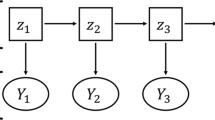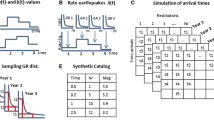Abstract
Earthquake occurrence is well-known to be associated with structural changes in underground dynamics, such as stress level and strength of electromagnetic signals. While the causation between earthquake occurrence and underground dynamics remains elusive, the modeling of changes in underground dynamics can provide insights on earthquake occurrence. However, underground dynamics are usually difficult to measure accurately or even unobservable. In order to model and examine the effect of the changes in unobservable underground dynamics on earthquake occurrence, we propose a novel model for earthquake prediction by introducing a latent Markov process to describe the underground dynamics. In particular, the model is capable of predicting the change-in-state of the hidden Markov chain, and thus can predict the time and magnitude of future earthquake occurrences simultaneously. Simulation studies and applications on a real earthquake dataset indicate that the proposed model successfully predicts future earthquake occurrences. Theoretical results, including the stationarity and ergodicity of the proposed model, as well as consistency and asymptotic normality of model parameter estimation, are provided.














Similar content being viewed by others
References
Adelfio G, Chiodi M (2015) Alternated estimation in semi-parametric space-time branching-type point processes with application to seismic catalogs. Stoch Environ Res Risk Assess 29:443450
Bartolucci F, Farcomeni A (2009) A multivariate extension of the dynamic logit model for longitudinal data based on a latent Markov heterogeneity structure. J Am Stat Assoc 104:816–831
Bartolucci F, Farcomeni A (2015) A discrete time event-history approach to informative drop-out in mixed latent Markov models with covariates. Biometrics 71:80–89
Bartolucci F, Farcomeni A (2015a) Information matrix for hidden Markov models with covariates. Stat Comput 25:515–526
Bartolucci F, Farcomeni A, Pennoni F (2013) Latent Markov models for longitudinal data. Chapman & Hall, CRC Press, Boca Raton
Baum LE, Petrie T, Soules G, Weiss N (1970) A maximization technique occurring in the statistical analysis of probabilistic functions of Markov chains. Ann Math Stat 41(1):164–171
Baum LE (1972) An equality and associated maximization technique in statistical estimation for probabilistic functions of Markov processes. Inequalities 3:1–8
Bulla J, Berzel A (2008) Computational issues in parameter estimation for stationary hidden Markov models. Comput Stat 23(1):1–18
Cameletti M, De Rubies V, Ferrari C, Sbarra P, Tosi P (2016) An ordered probit model for seismic intensity data. Stoch Environ Res Risk Assess 1–10. doi:10.1007/s00477-016-1260-4
Cosentino P, Ficarra V, Luzio D (1977) Truncated exponential frequency-magnitude relationship in earthquake statistics. Bull Seismol Soc Am 67(6):1615–1623
Davis PM, Jackson DD, Kagan YY (1989) The longer it has been since the last earthquake, the longer the expected time till the next? Bull Seismol Soc Am 79(5):1439–1456
Ebel JE, Chambers DW, Kafka AL, Baglivo JA (2007) Non-Poissonian earthquake clustering and the hidden Markov model as bases for earthquake forecasting in California. Seismol Res Lett 78(1):57–65
Fierro R, Leiva V (2017) A stochastic methodology for risk assessment of a large earthquake when a long time has elapsed. Stoch Environ Res Risk Assess 1–10. doi:10.1007/s00477-016-1288-5
Finazzi F, Fassò A (2016) A statistical approach to crowdsourced smartphone-based earthquake early. Stoch Environ Res Risk Assess 1–10. doi:10.1007/s00477-016-1240-8
Huang Q, Ikeya M (1998) Seismic electromagnetic signals (SEMS) explained by a simulation experiment using electromagnetic waves. Phys Earth Planet Inter 109(3):107–114
Hughes JP, Guttorp P, Charles SP (1999) A non-homogeneous hidden Markov model for precipitation occurrence. J R Stat Soc Ser C (Appl Stat) 48(1):15–30
Hutton K, Woessner J, Hauksson E (2010) Earthquake monitoring in southern California for seventy-seven years (1932–2008). Bull Seismol Soc Am 100(2):423–446
Leroux BG (1992) Maximum-likelihood estimation for hidden Markov models. Stoch Process Appl 40(1):127–143
Leroux BG, Puterman ML (1992) Maximum-penalized-likelihood estimation for independent and Markov-dependent mixture models. Biometrics 48(2):545–558
Levinson SE, Rabiner LR, Sondhi MM (1983) An introduction to the application of the theory of probabilistic functions of a Markov process to automatic speech recognition. Bell Syst Tech J 62(4):1035–1074
Ogata Y (1981) On Lewis’ simulation method for point processes. IEEE Trans Inf Theory 27(1):23–31
Ogata Y (1988) Statistical models for earthquake occurrences and residual analysis for point processes. J Am Stat Assoc 83(401):9–27
Ogata Y (1998) Space-time point-process models for earthquake occurrences. Ann Inst Stat Math 50(2):379–402
Orfanogiannaki K, Karlis D, Papadopoulos GA (2010) Identifying seismicity levels via Poisson hidden Markov models. Pure Appl Geophys 167(8–9):919–931
Park SK, Johnston MJ, Madden TR, Morgan FD, Morrison HF (1993) Electromagnetic precursors to earthquakes in the ULF band: a review of observations and mechanisms. Rev Geophys 31(2):117–132
Reid HF (1910) The mechanics of the earthquake, vol. II of Lawson, A.C., chairman, The California earthquake of April 18, 1906: report of the State Earthquake Investigation Commission: Carnegie Institution of Washington Publication, p 192 (reprinted in 1969)
Seeber L, Armbruster JG (2000) Earthquakes as beacons of stress change. Nature 407(6800):69
Sornette D, Knopoff L (1997) The paradox of the expected time until the next earthquake. Bull Seismol Soc Am 87(4):789–798
Team RC (2016) R: language and environment for statistical computing. R Foundation for Statistical Computing, 2005; Vienna, Austria
Telesca L, Giocoli A, Lapenna V, Stabile TA (2015) Robust identification of periodic behavior in the time dynamics of short seismic series: the case of seismicity induced by Pertusillo Lake, southern Italy. Stoch Environ Res Risk Assess 29:1437. doi:10.1007/s00477-014-0980-6
Utsu T (1961) A statistical study on the occurrence of aftershocks. Geophys Mag 30(4):521–605
Viterbi AJ (1967) Error bounds for convolutional codes and an asymptotically optimum decoding algorithm. IEEE Trans Inf Theory 13(2):260–269
Welch LR (2003) Hidden Markov models and the Baum–Welch algorithm. IEEE Inf Theory Soc Newsl 53(4):10–13
Zucchini W, MacDonald IL (2009) Hidden Markov models for time series: an introduction using R. CRC Press, Boca Raton
Zucchini W, Raubenheimer D, MacDonald IL (2008) Modeling time series of animal behavior by means of a latent-state model with feedback. Biometrics 64(3):807–815
Author information
Authors and Affiliations
Corresponding author
Electronic supplementary material
Below is the link to the electronic supplementary material.
Rights and permissions
About this article
Cite this article
Yip, C.F., Ng, W.L. & Yau, C.Y. A hidden Markov model for earthquake prediction. Stoch Environ Res Risk Assess 32, 1415–1434 (2018). https://doi.org/10.1007/s00477-017-1457-1
Published:
Issue Date:
DOI: https://doi.org/10.1007/s00477-017-1457-1




